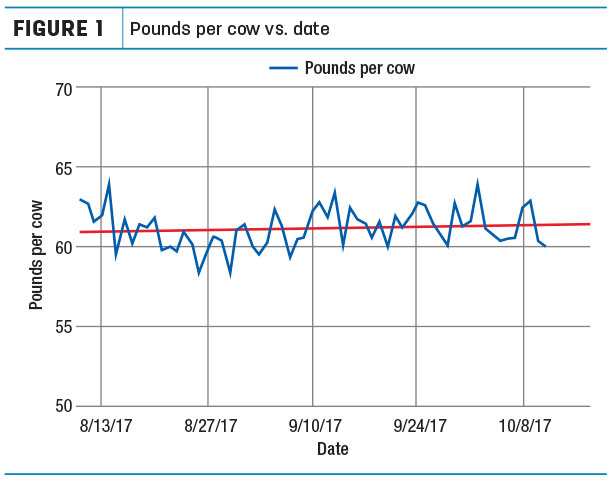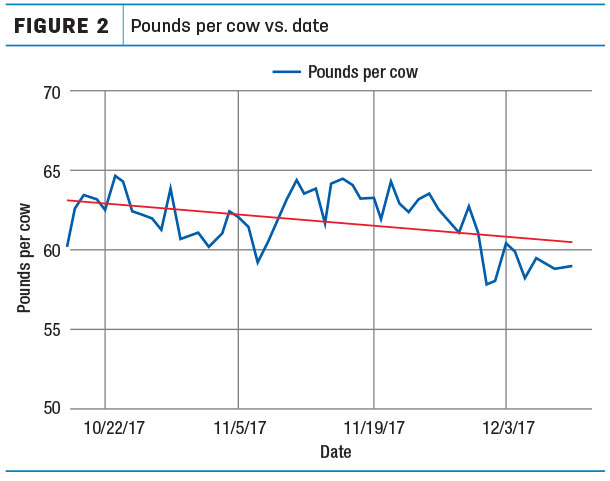It’s not uncommon to be right up against the edge with your forage inventory as new harvest is coming on. No one wants to run out, and ideally, no one wants to feed green forage either. It’s easy to do though. With rising cow numbers or a poor forage year, you can find yourself short on feed. Combine the two and you will certainly have a forage inventory problem that needs attention.
On our farm, I could see where we were going to have enough corn silage on hand to get to harvest, but we were not going to have enough fully fermented corn silage to last until the new crop had a chance to become stable.
Six weeks before corn silage harvest, we brought in 800 tons of fully fermented corn silage from a neighbor and repacked it. This would give the feed a chance to re-ferment if it was going to before we would need it. In a perfect world, we would have moved the feed in the winter when temperatures were more favorable for moving fully fermented forage, but nothing ever goes perfectly.
Our harvest date was Sept. 27. Up until harvest, we fed our own corn silage from the 2016 crop year. I graphed the pounds per cow from our Jersey herd for the 60 days we fed our own 2016 crop, including the transition to the purchased corn silage (Figure 1).

Pounds per cow in the low 60s is pretty typical for us in the late part of August and early September. I’ll use 61 pounds as our baseline production to compare what will happen once the corn silage starts to transition to new crop. We fully fed 2016 corn silage until Oct. 18. At that point, I started to slowly transition into new crop corn silage. My inclusion rate was the same at 16.93 pounds of dry matter or 41 percent of total dry matter intake. On our fully fermented corn silage, the production per cow was uneven day to day as we started to pull away from the most humid weather. We seemed to always hit the 60-to-64-pound range, with the general trend line suggesting that we were heading upward in the right direction.
Once we started the transition into new crop corn silage, we noticed the trend go the other direction in a hurry (Figure 2). Production swings were more prevalent and extreme. Dry matter and bunk scoring could be right on the money, but production per cow was bouncing 2 to 4 pounds from one day to the next. This is the kind of stuff that gives me the gout.

Once we were completely on new feed, there were more days of production being lower than 60 pounds per cow. That just isn’t going to cut it. We couldn’t blame the heat; that was behind us. We couldn’t blame overcrowding. We have made more milk with the same pen densities. The other components of the ration stayed exactly the same. The only difference here was moving from old crop silage to new crop.
I always start to transition to a different feed at a very low inclusion rate over several days. In fact, I spread the transition of the two crop years over 45 days. It took me from Oct. 18 until Dec. 4 to fully transition to new crop corn silage. As you can see from the graph above (Figure 2), the feed is not fully ready to go yet. As we pulled completely away from the fully fermented corn silage, production took a dive.
Here are the major components for the corn silage samples of the past two years (Table 1). Under physical inspection you would call them very similar – a substitution should not be a problem. Looking at the forage tests, you could also draw the same conclusion. They are pretty close, but are they?

The dry matter of each sample is close enough to not really matter. I still adjusted for it, but it wasn’t a major change. I know that the 2017 crop was sampled from the last loads of the most immature corn that always finishes the pile. That statement should also tell you a little about the difference in the two digestibility numbers of 60.8 and 54.2, respectively. That real green corn that goes on top and on the edges to seal up the pile is probably not the best stuff to rely on for taking a sample. It’s also telling that my cows took a dive in production once on the full feed of new crop. That tells me we are not out of that green stuff yet.
I would expect production to rebound as we get into the new crop a little more. In the meantime I’ll be doing a little substituting to keep the milk flowing and resampling our new corn silage more aggressively to find our baseline numbers for digestibility, starch and dry matter.
Having a carryover pile of fully fermented corn silage ready to go at all times is easily worth 3 pounds of milk per cow on the low end in this example. If you want to measure between extremes, it has been closer to 6 pounds per cow. I’ll right the ship; I always do. We will have to do better for next year. Forage shortfalls are real. Now is a good time to see if you have enough on hand to get you 60 days past harvest. If not, you have time to adjust if you start today.
You can get my complete library of dairy nutrition articles at Dairyhack.com. ![]()

-
Jim VanDerlinde
- Dairy Producer, Consultant
- Hillview Dairy
- Lewisburg, Pennsylvania
- Email Jim VanDerlinde




